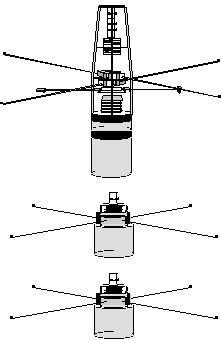SIERRA
The purpose of the SIERRA mission is to investigate the primary causes of transverse ion acceleration in the topside auroral ionosphere up to 1000 km altitude.
The experiment consists of a main payload and two identical sub-payloads separated by hundreds of meters in a triangle configuration within a plane perpendicular to the geomagnetic field. This configuration allows resolving space time ambiguities and provides information on structure at scale lengths of less than 1Km.
 SIERRA is scheduled for launch in January 2001 from Poker Flat Range, Alaska.
SIERRA is scheduled for launch in January 2001 from Poker Flat Range, Alaska.
Main payload instrumentation:
Cornell University:
- Science magnetometer on 1 meter boom
- 2 sets of 6 meter Weitzmann E-field antennas
- VLF E-field and plasma wave electronics (DC to 20KHz)
- GPS reciver for 3 meter relative positioning and microsecond timing
UNH:
- HEEPS-E 5eV to 16KeV electron detector
- TED .01 to 10eV thermal electron detector on 1 meter boom
- HEEPS-I 10eV fixed energy ion detector
- BEEPS 6eV to 200eV ion detector with O+ H+ separation
Dartmouth:
- HF E-field reciever (100KHz to 5MHz)
Sub-payload instrumentation (each payload):
Cornell:
- Science magnetometer
- 2 sets of 5 meter Yo-Yo deploy E-field antennas
- VLF E-field and plasma wave electronics (DC to 20KHz)
- GPS reciver for 3 meter relative positioning and microsecond timing
UNH:
- HEEPS-I 10eV fixed energy ion detector.
Principal Investigator:
Co-Investigators:
- Roger Arnoldy / UNH
- Kristina Lynch /UNH
- Mark L. Psiaki /Cornell University
- James W.Labelle / Dartmouth College

